Bry-sur-Marne to Lagny-sur-Marne
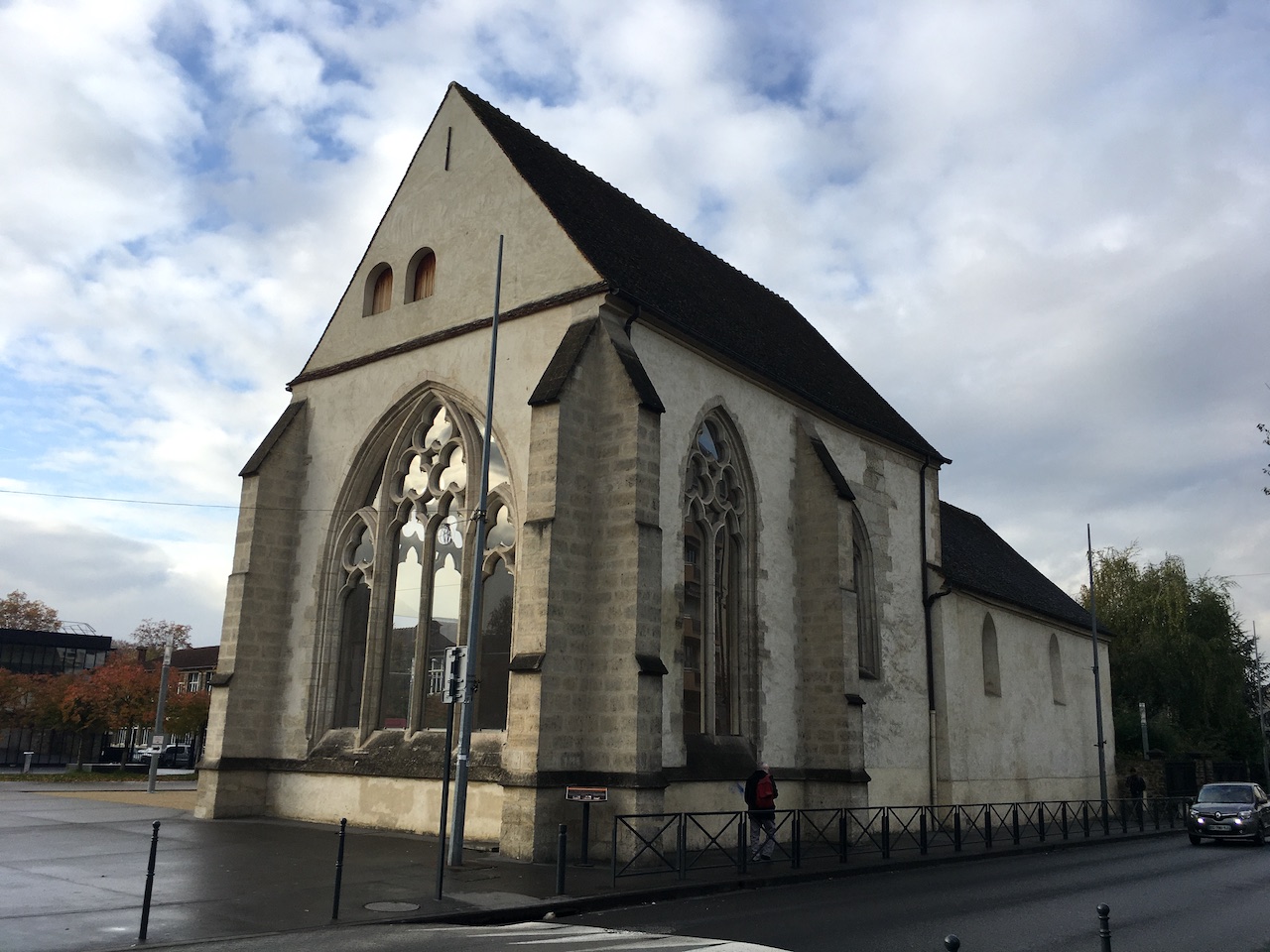
Île-de-France
12. Bry-sur-Marne to Lagny-sur-Marne
Medium
6h
21,9km
+132m
-120m
Step
Embed this item to access it offline
On this stage we still find the traces of the ginguettes that animated the banks of the Marne last century, the bourgeois stone houses, the history of the Maison du Chocolat Meunier and its mill and the green banks of the Marne as far as Lagny-sur-Marne. The route of Saint Colomban en Brie will also allow you to visit the churches along the route and appreciate the landscapes that have inspired many painters.
7 points of interest

Église Saint-Gervais-Saint-Protais à Bry-sur-Marne - Association Colomban en Brie TouristKirche Saint-Gervais-Saint-Protais in Bry-sur-Marne
Bevor Louis Daguerre (1787-1851) die Daguerreotypie erfand und einer der Väter der Fotografie wurde, war er mit seinen Dioramen äußerst erfolgreich: transluzente bemalte Leinwände, die er mit hinter ihnen platzierten Lichtern animierte. Diese im Chor platzierte Trompe-l'oeil-Leinwand verwandelt die kleine Kirche von Bry-sur-Marne in eine imaginäre Kathedrale. Daguerres andere Gemälde sind auch im Hôtel de Malestroit in Bry zu sehen, ebenso wie Beispiele von Daguerreotypen.
Informationen: Rathaus unter 01-45-16-68-00/Museumsservice unter 01-45-16-68-33.
Zu besuchen in Bry-sur-Marne:
Hôtel de Malestroit: 2, grande rue Charles-de-Gaulle, 94360 Bry-sur-Marne.
Maison Daguerre: 4, rue du 136e de Ligne, 94360 Bry-sur-Marne.
Adrien Mentienne Museum - Espace Joron: 6 bis, grande rue Charles-de-Gaulle, 94360 Bry-sur-Marne.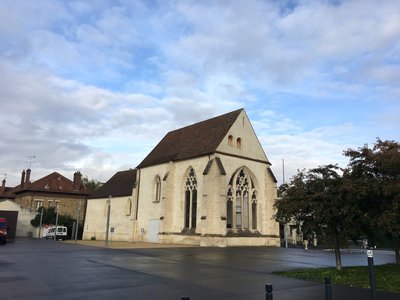
Façade nord des églises Sainte-Croix et Saint-Georges - Association Colomban en Brie TouristThe churches of St. Croix and St. George
The complex is located near the town hall and consists of two adjoining churches. They were built on the site of the 6th century oratory of Saint Clothilde.
In the 9th century this site was occupied by the canons and the nuns settled a little further east. The current church of St. George (11th and 12th centuries) is typical of Romanesque times with its small openings. The Sainte-Croix church, the highest of the two churches, is a 13th century Gothic style church with large bay windows.
Abandoned and partly destroyed during the Revolution, they were used as commercial premises until the middle of the 20th century. Classified as a historical monument in 1984, they were restored in 2002 to become a centre for contemporary art in the city of Chelles.
Église Saint-André à Chelles - Association Colomban en Brie TouristSaint-André Church in Chelles
We do not know the date of its construction a first mention dates from the 12th century, this parish church is probably of older origin. The choir and chapels were built between the 13th and 15th centuries. The nave was rebuilt in the 18th century.
During the destruction of the abbey during the Revolution, the relics displayed in the abbey church were placed in the Saint-André church where the reliquaries of Saint Bathilde, her daughter Saint Radegonde, Saint Clotilde first abbess and several abbesses can be admired.
Clotaire III, son of Bathilde, was buried there.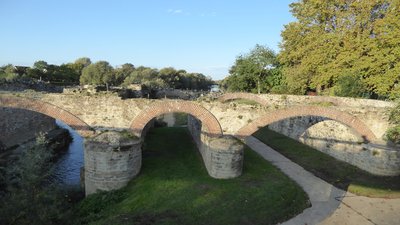
Vestiges des fondations du Moulin de Chelles - Association Colomban en Brie TouristThe old mills of Chelles
Located on the banks of the Marne and via Columbani, the remains of the Chelles mills are surrounded by a park created in 1989 to replace an old poplar grove. There are many varieties of trees.
In the middle of the 19th century, the Chelles mill supplied "La Vermicellerie", a pasta factory. It was bought around 1877 by the industrialist Menier who wanted to use the river without constraint. Indeed, the Chelles mill, located downstream of the Noisiel mill, hinders the functioning of the latter. Transformed by the Meniers (notably the installation of a horizontal transmission), the factory was built on stone arches, still visible today and the floors are made of wood and cob. The site was abandoned in 1895 after several fires.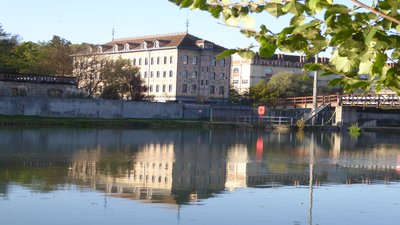
Moulins de Noisiel vue depuis la Via Columbani - Association Colomban en Brie TouristNoisiel Mills
The Noisiel Mill was certified in the 11th century and was used to mill cereals until the 19th century.
The inhabitants very early took advantage of the presence of the Marne: a commercial port developed in the 15th century to transport wood to Paris.
The land and mill of Noisiel belonged to several generations of lords. Jean Antoine Brutus Menier first acquired the Moulin in 1825 from the last Duke of Lévis to grind pharmaceutical powders. The Duke's heir, the Count of Nicolay, then gradually ceded the land, the farms and the castle in 1879.
Menier Chocolate Factory in Noisiel
In 1825, Jean-Antoine-Brutus Menier acquired the Noisiel mill and three hectares of land. This site is at the origin of the creation of a factory for the industrial manufacture of chocolate.
The mill site has undergone several transformation phases since the arrival of the Meniers in 1825 and the presence of a mill to spray pharmaceutical substances. From the 1860s onwards, the company became a real industrial complex where the organisation of the factory space was completely rethought. The buildings are then ordered according to the manufacturing process.
The design of the mill by Jules Saulnier (1817-1881) is the successful combination of Art Nouveau architecture of the late 19th century and industrial functionality. The industrial complex was completed in 1874 by the construction of a workers' city.
Until 1924, the reconstructions and new buildings, made necessary by the increase in production, perfectly integrated the technical progress of the 19th century, as well as an exceptional architectural aesthetic.
After the Menier family left in 1960, the land in the complex was sold to several successive groups. The former Menier chocolate factory was converted into a head office by the Nestlé-France SAS group in 1996. This reconversion by architects Reichen and Robert is based on "the dialogue between contemporary and old architecture".
La façade de l’église Saint-Furzy ayant survécu à la démolition à Lagny-sur-Marne - Association Colomban en Brie TouristThe Saint-Pierre de Lagny-sur-Marne
The Saint-Pierre de Lagny-sur-Marne monastery was founded by Saint Fursy (Fursey - Fursa - Forseus) in the 7th century.
Fursy is celebrated as one of the most important of all Irish missionary monks in the 7th century with Saint Colomban.
Born in Ireland into a noble family, this visionary travelled throughout England before coming to the continent to found the monasteries of Lagny and Peronne.
He arrived in a region where Luxembourg monasticism was expanding rapidly and the royal courts welcomed the Irish monks with great kindness, on a par with Erchinoald, mayor of the Neustrie palace, who proposed to Fursy to build a monastery in Lagny-sur-Marne.
Founded around 644 the monastery received donations from Clovis II and Bathilde, ruined by the Normans in the 9th century it was rebuilt. During his consecration King Robert the Pious offered a nail of the True Cross which was lost a few centuries later.
The monastery was sold as national property in 1797 to become a hospital and then the town hall of Lagny-sur-Marne in the middle of the 19th century. The complex was classified as a historical monument in 1886 and 1969.
Today, three buildings rebuilt over the centuries bear witness to the history of this illustrious abbey founded by Saint Furzy. The town hall with the old cloister, the Saint-Furzy church and the Notre-Dame des Ardents church. In 1430, Joan of Arc came to pray in this church where she performed the miracle of the resurrection of the dead child.
More information: Wikipedia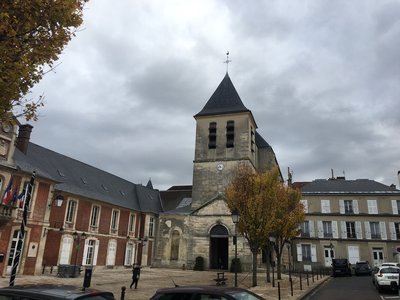
FR-610SC-83-77400-Lagny-église-ND-Ardents-PO7-1 - Association Colomban en Brie TouristChurch of Notre-Dame des Ardents in Lagny
From the 7th century onwards, this Notre-Dame church became part of the Saint-Pierre de Lagny monastery. The proximity of the churches dedicated to the Apostle Peter and the Virgin Mary is a classic feature of the early Middle Ages, particularly in Irish foundations.
The church destroyed in the 10th century during the Norman invasions, rebuilt in the 11th century when the inhabitants suffered from the evil of the ardent. The church was consecrated under the name of Our Lady of the Ardents. Several fires partially destroy the building, which will be rebuilt after each destruction.
In 1430, Joan of Arc came to pray in this church where she performed the miracle of the resurrection of the dead child.
After the church was closed during the Revolution, work was undertaken in the middle of the 19th century.
Description
From the church of Bry-sur-Marne, cross Place Daguerre at the roundabout and take the Bry-sur-Marne bridge
- After crossing the Marne, take the stairs to the right quai de Champagne, quai d'Argonne.
- Leave the Argonne quay by taking the pedestrian path along the Marne, André Devambez walk (yellow markings), go under the railway, then the towpath. Pass under a railway bridge, then under a road bridge in Neuilly-sur-Marne
- Take the bridge on the right, cross the canal de Chelles, Chemin de l'Écluse, exit the bridge on the left pedestrian way along the canal, after following the campsite on your right turn right then second path on the left to follow the right bank of the Marne,
- Turn left and cross the Haute-Ile departmental park, stay on your right at the crossroads, at the small car park take the second road on the left straight ahead to follow the bank of the Marne, go under the Chetivet bridge, on the right walk Marx Dormoy, at the crossroads on the left rue de Gournay, cross the canal
- On the right avenue du Maréchal Foch, cross avenue du Général-de-Gaulle to continue on avenue Maréchal Foch, go under the railway, take the entrance to the Remembrance Park, after the playground on the left, cross rue des Frères Verdeaux, go around the town hall on the left, cross the car park, rue Louis Eterlet
- At the roundabout, place de la République straight ahead rue Sainte-Bathilde, crossroads with rue Duchesne, straight ahead D 934, avenue François Mitterrand, go under the railway line, avenue Auguste Meunier, go around the oval-shaped median on the right, take the fourth street on the right rue Auguste Meunier, cross the canal de Chelles, rue du Moulin, cross the quay Auguste Prévost, allée du Moulin, take the bridge over the Marne
- At the exit of the footbridge, turn left onto Chemin Ceinture verte d'Île-de-France (red and yellow markings), with the Marne on your left. Cross the barrier to enter the park of the leisure centre.
- Take the next footbridge on the left on the Marne footbridge towards Île de Vaires. Turn right and enter the forest of Île de Vaires to follow the right bank of the Marne, bypass the Noisiel dam
- After a curve to the left, leave the serviced road to take a path to the right along the Marne. Continue along the right bank of the Marne, ignoring all departures on the left. Pass under the Vaires bridge Cross lock n°15 of Vaires-sur-Marne on the Chelles canal.
- Take immediately to the right the towpath of the Marne. Pass under high voltage lines and then under a motorway bridge. Continue between a railway track on your left and the Marne on your right, continue on quay Eugène Gaudineau, stay on the road bordering Marne, pass under Joffre bridge on your right Maunoury bridge, exit the bridge straight ahead, rue du Chemin de Fer
- Cross rue Saint-Denis, rue des Marchés, place de la Fontaine on the left rue de l'Arcade, on the right rue de l'Hôtel-de-Ville you arrive place de l'Hôtel-de-Ville in front of the church Notre-Dame-des-Ardents.
- Departure : Church Saint-Gervais et Saint-Protais, 4 avenue Charles de Gaulle-94360-Bry-sur-Marne
- Arrival : Church Notre-Dame des Ardents, 1 rue du docteur Nodier-77400-Lagny-sur-Marne.
- Towns crossed : Île-de-France
Altimetric profile
Report a problem or an error
If you have found an error on this page or if you have noticed any problems during your hike, please report them to us here:









